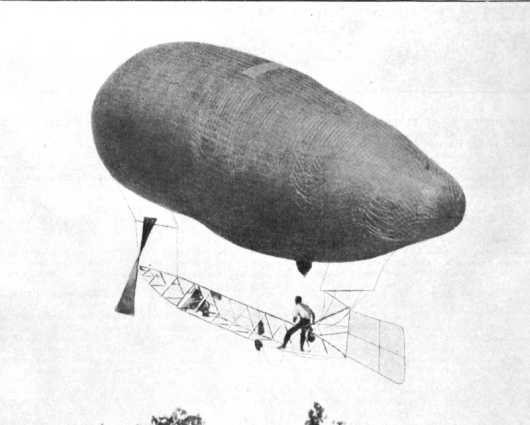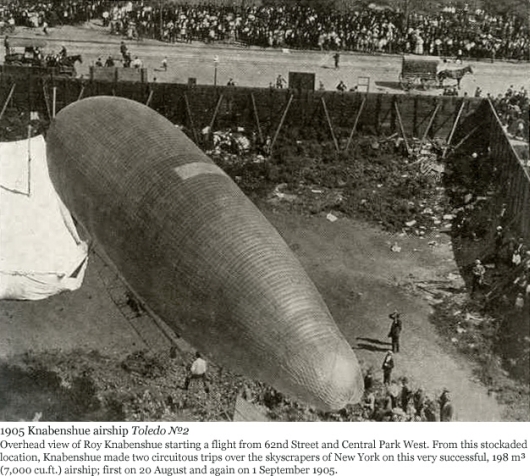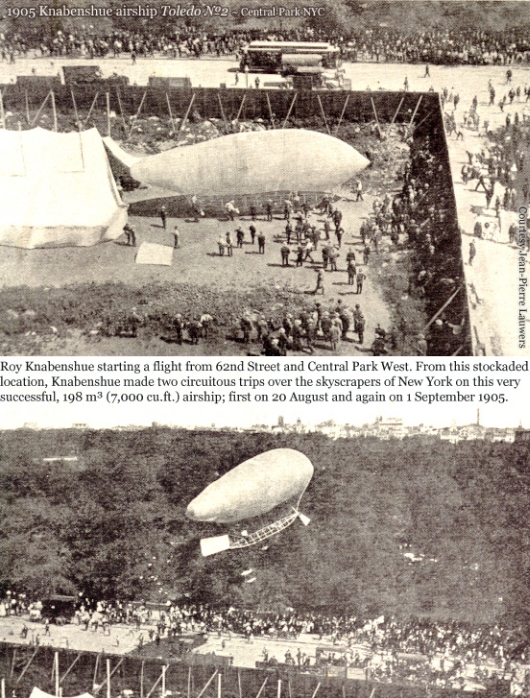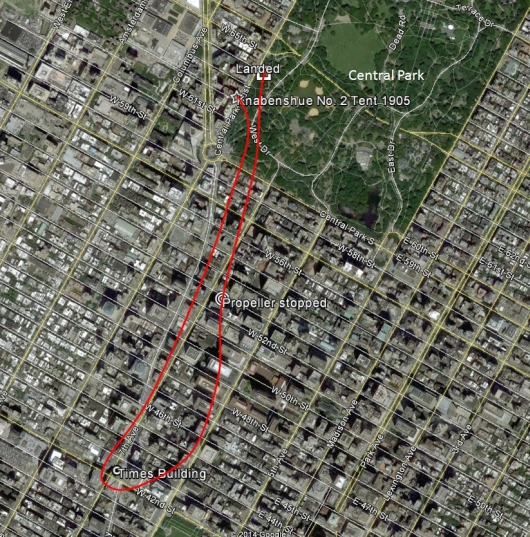The "Knabenshue Toledo No. 2"
Photo credit: Public Domain
(Photo is was taken in Aug, 1905 as the Toledo No. 2 ascended from just outside Central Park, New York City.)
Construction
(Note: Though the Toledo No. 1 and No. 2 were built at the same time and are virtually identical, I separated the Toledo No. 2 from the Toledo No. 1 because, not only were they two, distinct craft, but they were photographed and made history separately. The construction details of the No. 2 are clearly, largely the same as the No. 1, so please forgive the similarities in the descriptions on this page! There is another "No. 2" which is often confused with this, the original No. 2. But the later "No. 2" was a larger craft, and I will dedicate a separate page to it, TBD.)
Not much is written about the Knabenshue airships in terms of construction, but what one can see from photos, Knabenshue's No. 1 & No. 2 were clearly influenced by the airship design of Thomas Baldwin. Photos of the "Knabenshue No. 1" and "No. 2" not only look very much alike themselves, but both are clearly based on Baldwin's "California Arrow" which Knabenshue piloted on October 25, 1904 at the St. Louis World's Fair. Each suspend a triangular cross-section frame catwalk as a "control car" under a square-mesh net of strong cord which, which, upon inflation of the the gas bag, contains and holds the gas bag captive.
Though it is hard to see in photos the most visible difference between the No. 1 and No. 2 appears to be the rudder design. (See photo comparison at the bottom of this page.) Both initially had a rudder-only, that is no horizontal stabilizer built into the rudder, the so-called "cruciform" rudder. The rudder of the No. 1 shows "6-panels" while the No. 2 shows "4-panels". (I am not suggesting separate panels forming the rudder, but only the "appearance" of separated panels.) It is not surprising that Knabenshue made many changes to each airship as he learned from experience or simply made improvements after flights.
Constructed through the winter of 1904 and the spring of 1905, Knabenshue’s No. 2 was ready for flight in mid to late 1905, either at the same time or soon after the No. 1 was ready. (The No. 1 was first flown in Jun, 1905, and the No 2 first flown in New York in August!) The control "car" was 38 feet long, made up of square spruce struts (painted a silver color resulting in an "aluminum" appearance) and piano wire cross bracing making the entire frame very rigid. The gas bag is cigar-shaped, 62 feet long, made of Japanese silk "painted" with a special "varnish" developed by Knabenshue himself, and a capacity of 7,000 cubic feet of hydrogen. The "tapered" appearance of the aft of the gas bag was intentional as Knabenshue, having flown the California Arrow with its symmetrically-shaped bag, already felt the tapered design gave greater stability.
It is with great fortune that Mr. Knabenshue was able to complete the construction of his first two airships as vandals broke into his workshop on May 24th, 1905, and cut up and nearly destroyed one of the gas-bags!
Nevertheless, he recovered from the vandalism and had the No. 1 ready to fly in June, 1905, and shipped the No.2 to New York for exhibition flights in August! (The No. 1 was also shipped to New York, but it was not flown.)
Operations
The Toledo No. 2 was also an "exhibition" vehicle - that is, having no military or commercial value. Though the 1917 "D'Orcy Airship Manual" lists Roy Knabenshue as an airship builder [then in Pasadena, CA], it only states "Builder of numerous airships of the car-girder, pressure type, all of which served exhibition purposes but one which is listed herewith." Ouch! (Knabenshue's 1913 "Pasadena" passenger airship was the only listing.)
But Roy Knabenshue's pioneering work was done prior to 1917, and what he accomplished is nothing short of amazing. The fact that he earned such a "meh" entry in the D'Orcy manual in no way detracts from what Roy Knabenshue accomplished! Imagine assembling the parts, standing on a narrow triangular framework, while ascending and descending only by climbing forward or aft along the rickety framework!
The airship's altitude was not regulated by means of a gas valve attached to the balloon. It had no valve! When the gas-bag is filled with hydrogen the silk neck of the gas inlet was simply tied-off with a piece of rubber. Elevation was provided by the quantity of gas in the gas-bag, then after rising to a certain height the gas expanded due to the decrease in atmospheric pressure and said pressure would overcome the constraint of the rubber tie around neck of the gas inlet - releasing some of its volume and allowing the machine to settle to stabilize at altitude! Of course, as the sun further heated the gas, the whole process would repeat, limiting the vehicle's altitude and endurance.
Otherwise, Mr. Knabenshue would descend by scrambling forward on the gondola's framework, thus using his weight to tilt the nose of the balloon downward, and using the thrust by the propeller alone, the airship was "pulled" downward. (Similarly, to ascend, the pilot only needed scramble aft.) Only about 20 pounds of ballast was carried for emergencies. There was also no "throttle"! The ship's speed was what it could attain at a fixed RPM. Nevertheless, surviving motion picture videos of the era show these airships took off rapidly and achieved their maximum speed rather quickly. This is why we see photos of these airships ascending so close to obstacles. Once launched, they could ascend rapidly!
Roy Knabenshue admitted in interviews that only in the absence of heavy wind, was it possible by means of propeller thrust and rudder to guide the airship. The practical airship of the future, he said, "would need to dispense with the huge gasfilled bag which offers more resistance to the air currents than the canvas of a fair-sized sailing vessel."
Demise
Honestly, I could find nothing in the available record regarding the fate of the Knabenshue Toledo No. 2. I do not know if it crashed, or if it simply aged out of service. I do know that Knabneshue continued to build larger and more capable ariships, so it is entirely possible that the No. 2 was simply "parked" having fulfilled its role in progress in lighter-than-air flight.
By 1909, public interests in airships waned as airplanes were becoming all the rage. Knabenshue himself went to work for the Wright Brothers a planner for their "Wright Flier" exhibitions.
Ignominious End
In 1912 Knabenshue returned to airship work and started a dirigible passenger flight service in Pasadena, California. In 1914 he flew his dirigible "White City" over Chicago. This ship made history in 1913 and 1914 by doing aerial sightseeing over the Middle West.
During World War I, Knabenshue built observation balloons for the Army. Later, he worked for the National Park Service till he retired in 1944, and spent the next 10 years or so doing odd jobs helping recondition aircraft.
Augustus Roy Knabenshue held Balloon License Number 31, Dirigible License Number 4, built ten airships and numerous balloons, was a prominent member of the Early Birds and had earned a significant place in American aviation history. He died on March 6th, 1960, nearly destitute, living on a meager pension income.
Sites of Interest
New York, Central Park
On Aug 20th and Sep 1st, 1905, Roy Knabenshue flew his Toledo No. 2 over the skies of New York City, much to the delight of thousands of onlookers who may have heard of an airship, yet probably never dreamed they'd be in the right place at the right time to actually see one! Knabenshue built a "fortress" on an empty lot at the corner of 62nd Ave and Eighth Ave (now Central Park West), and assembled and prepared the No. 2 for flight.
Photo credits: Rosebud's on-line archive
http://www.earlyaeroplanes.com/archive3.htm#kites
And this next terrific photo, the Toledo No. 2 is seen from above, possibly just emerged from its tent. These photos, and the shadows contained, suggest that the Airship's fortress was right on the NW corner of the intersection of 62nd Ave and Central Park West. In the lower half of the photo below, the Toledo No.2 is ascending over Central Park West.
Photo credits: Rosebud's on-line archive
http://www.earlyaeroplanes.com/archive3.htm#kites
(Note the dilemma this photo poses! What looks like a "rudder" is laying on the ground in the upper portion of this photo, while in the lower portion, the rudder of the ascending airship sure looks like the rudder of the No. 1! A newspaper article said Knabenshue had the No. 1 with him in New York but that he had no plans to fly it. So it seems that this photo is of the ascension on Sep 1, 1905, and that for whatever reason, Mr. Knabenshue decided the longer rudder of the No. 1 would be better than the shorter one on the No. 2. The propeller shown in this photo is most certainly the No. 2, and the gas tank position is below the top rail as it was for the No. 2, so what we have here is evidence that Mr. Knabenshue simply did what he needed to do to ensure a successful flight that day - swapping parts as needed!)
So the location in New York City is seen here in Google Maps, (Lat Lon) 40.770323 -073.980757:
Photo credits: Google maps
An Aug 21, 1905 article in the New York Times described the flight of the Toledo No. 2 on its Aug 20th flight. From that description I've made the following estimated flight path. Of course, the pat is just a guess, but the article said Knabenshue headed south, circled around the Time Building (now One Times Square), then returned with the wind, northerly. About 53rd St, the propeller failed, yet, Knabenshue was able to guide the Toledo No. 2 to a landing in Central Park just opposite 64th St.
Photo credits: Google Earth
The newspaper article stated that not fewer than 300,000 people had streamed out onto New York streets and sidewalks that day to witness Roy Knabenshue fly his Toledo No. 2 over New York!
Toledo No. 1 vs Toledo No. 2 Comparison
Since it is hard to see in the often low-quality reproductions of photos from this era, and The No. 1 and No. 2 are oftern confused, here is a comparison of the visible differences between the Knabenshue Toledo No. 1 and No. 2:
Photo credit: Compiled from Public Domain photos
(Both photos above are from a 1905 issue of Collier's magazine.)





